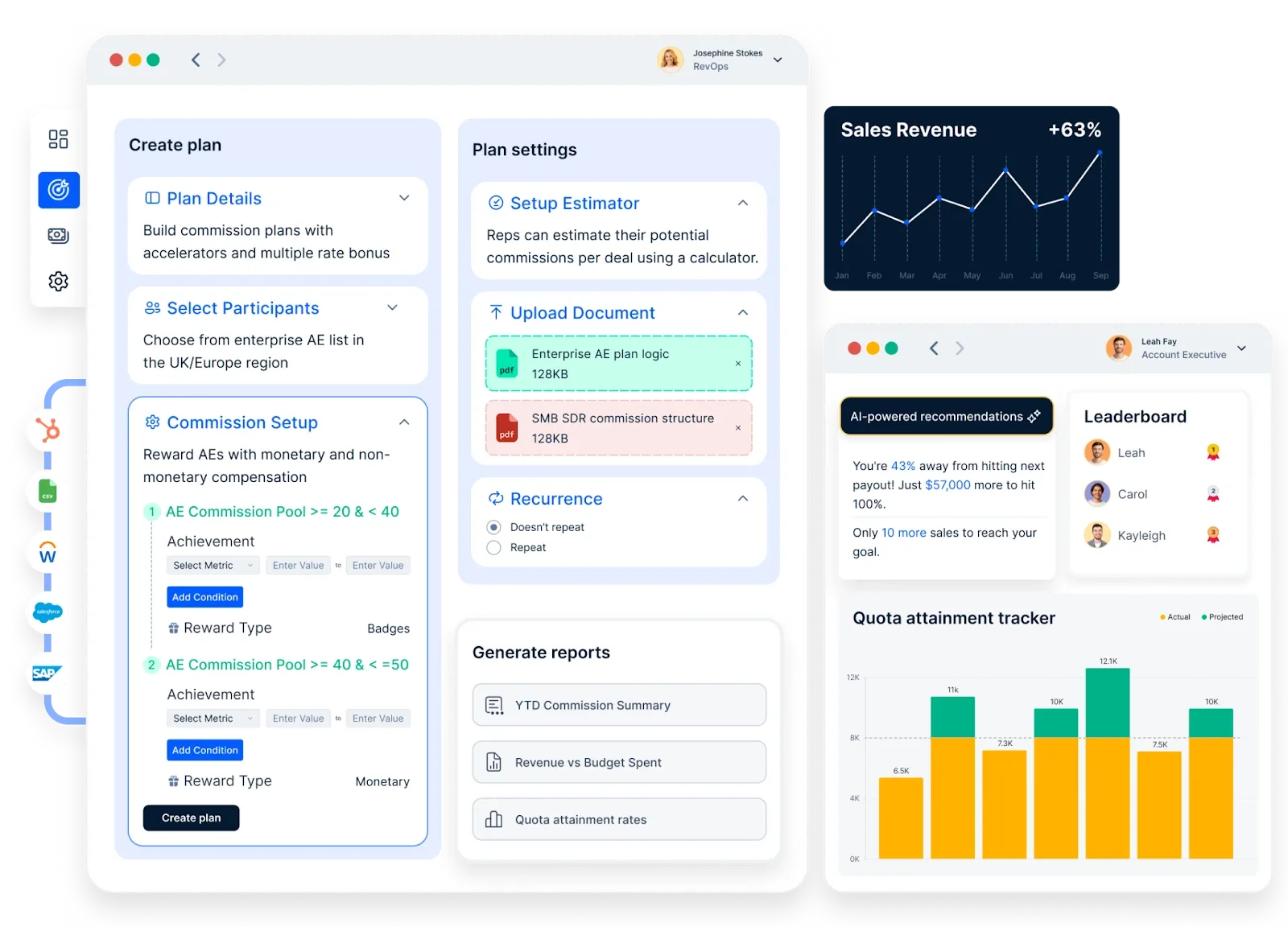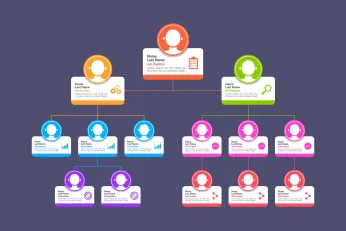On this page
A well-designed commission structure can be the key to driving success in your sales team. When you have the right structure in place, you’ll attract top talent who are motivated to close deals and consistently perform.
On the other hand, a poorly structured commission plan may lead to high turnover, as your best sellers might seek better opportunities elsewhere. This is every bit real and is giving sleepless nights to countless sales leaders. A 2018 report by the Bridge Group shows that the average tenure of a Sales Rep is just 1.5 years.
In this article, we’ll explore what a sales commission structure is, walk you through the various types of sales commission structures, and provide tips on how to structure sales commission plans effectively.
What is a sales commission structure?
A sales commission structure typically outlines how a company will pay its salespeople and the amount it will pay for each sale. This is determined by various factors such as the company’s budget allocations for commissions, base salaries, different levels of sales performance, the products a company sells, the industry it belongs to, and other incentives built into the compensation plans.
Commission structures play a key role in motivating employees to achieve objectives that directly impact an organization’s success.
Why are commission structures crucial for your sales team?
A well-designed commission structure can have a significant impact on your organization’s performance. It not only drives sales team motivation but also sets clear expectations, fostering a culture of high performance. By aligning incentives with business goals, a good commission structure helps ensure your team is working toward the right objectives.
Furthermore, a thoughtfully crafted sales commission structure plays an essential role in attracting top talent and retaining high performers within your sales team.
However, selecting the best sales commission structure can be complex due to the multiple factors involved. From understanding different sales commission structures to knowing how to structure sales commission effectively, it’s important to customize your approach based on your company’s specific needs and goals.
8 types of sales commission plans/structures with formulas and examples
Whether you're trying to figure out how to structure sales commission for your team or refine an existing plan, this breakdown will help you make informed decisions.
1. Base salary + commission
This structure combines a fixed salary with a variable commission based on sales performance. It provides financial stability to sales reps while incentivizing them to close deals.
Benefits:
- Provides security with a steady income.
- Encourages sales reps to strive for higher earnings.
- Helps businesses retain top talent.
Total Compensation = Base Salary + (Sales Revenue × Commission Rate)
Example:
A sales rep with a $40,000 base salary and a 10% commission rate who generates $200,000 in sales would earn: $40,000 + ($200,000 × 10%) = $60,000.
To break it down further, the sales rep earns a guaranteed base salary of $40,000 per year. If they generate $200,000 in sales, they receive an additional $20,000 in commissions, making their total earnings $60,000. This structure provides a balance between stability and motivation to sell more.
2. Commission only
Under this model, sales reps earn income solely from commissions, with no base salary. This is common in industries with high-ticket items or entrepreneurial sales roles.
Benefits:
- Highly performance driven.
- Reduces fixed costs for businesses.
- Motivates sales professionals to maximize revenue.
Total Compensation = Sales Revenue × Commission Rate
Example:
A rep with a 15% commission rate who sells $100,000 worth of products earns: $100,000 × 15% = $15,000.
For instance, if a real estate agent follows this model and sells a house for $500,000 with a 3% commission rate, their earnings from this sale would be $15,000. However, if they do not close any deals, they earn nothing, making this structure highly performance-driven but also riskier.
3. Tiered commission
This structure rewards sales reps with higher commission rates as they achieve specific sales thresholds.
Benefits:
- Encourages higher sales volume.
- Rewards top performers.
- Provides a clear pathway for earnings growth.
Total Compensation = (Sales Revenue × Commission Rate) (for each tier)
Example:
- 5% commission on sales up to $50,000
- 7% on the next $50,000
- 10% on sales beyond $100,000
If a rep sells $120,000: ($50,000 × 5%) + ($50,000 × 7%) + ($20,000 × 10%) = $3,900.
For more clarity, the rep earns $2,500 on the first $50,000, an additional $3,500 on the next $50,000, and $2,000 on the remaining $20,000. This structure rewards higher sales efforts with better earnings.
For more clarity, the rep earns $2,500 on the first $50,000, an additional $3,500 on the next $50,000, and $2,000 on the remaining $20,000. This structure rewards higher sales efforts with better earnings.
4. Draw against commission
This structure provides an advance (draw) on future commissions, which sales reps must pay back through their earnings.
Benefits:
- Offers financial support during slow periods.
- Helps new reps ramp up sales efforts.
- Reduces turnover in industries with long sales cycles.
Total Compensation = Commission Earned - Draw Amount
Example:
If a rep receives a $3,000 draw but earns $4,000 in commission, their paycheck will be $1,000 ($4,000 - $3,000).
For instance, if a new sales rep receives a guaranteed draw of $2,500 per month but only earns $1,500 in commissions in the first month, the company covers the $1,000 shortfall. However, in the next month, if the rep earns $3,500, the company deducts the previous shortfall, and the rep receives $2,500 ($3,500 - $1,000).
5. Territory volume commission
Sales reps earn commissions based on total sales generated within a specific geographic territory rather than individual sales.
Benefits:
- Encourages teamwork and collaboration.
- Prevents competition among reps in the same region.
- Helps businesses penetrate new markets effectively.
Total Compensation = Territory Sales Revenue × Commission Rate
Example:
If a sales team in a region generates $500,000 in sales and the commission rate is 8%, the team shares: $500,000 × 8% = $40,000.
Each rep's share depends on their contribution to the total sales volume. If three reps contributed equally, each would earn $13,333.
6. Residual commission
Sales reps continue earning commissions on recurring sales or renewals from previous clients.
Benefits:
- Provides long-term earning potential.
- Encourages reps to maintain customer relationships.
- Ideal for subscription-based businesses.
Total Compensation = Recurring Revenue × Commission Rate
Example:
A software sales rep who closes a $2,000 monthly subscription with a 10% commission earns: $2,000 × 10% = $200 per month as long as the client remains subscribed.
7. Gross margin commission
Commissions are calculated based on profit margins instead of total sales revenue.
Benefits:
- Encourages reps to sell higher-margin products.
- Aligns sales incentives with company profitability.
- Helps control discounting practices.
Total Compensation = (Revenue - Cost) × Commission Rate
Example:
If a rep sells a product for $5,000, but the cost to the company is $3,000, and the commission rate is 15%, their earnings are: ($5,000 - $3,000) × 15% = $300.
8. Multiplier commission
This structure adjusts commissions based on performance metrics, such as quota achievement or customer satisfaction.
Benefits:
- Rewards overperformance.
- Aligns incentives with key performance indicators.
- Encourages reps to exceed their targets.
Total Compensation = Base Commission × Performance Multiplier
Example:
A rep earns a base 5% commission, but if they exceed 120% of their sales target, the multiplier increases their commission by 1.5x: (Revenue × 5%) × 1.5.
If the rep generates $100,000 in sales, their earnings increase to: ($100,000 × 5%) × 1.5 = $7,500.
By understanding these different sales commission structures, businesses can select the best sales commission structure that aligns with their goals while motivating their sales teams.
Average sales commission rates by industry
Determining the right sales commission rate for your sales team will require you to take a variety of factors into accounts, such as the base salary, nature of products and services, and the degree of research and technical knowledge required.
While there is no magic formula to getting this right, looking at the median average pay for your industry can give you a fair idea of what works well.
- Wholesale & Manufacturing Sales Representative: $61,660
- Advertising Sales Agents: $51,740
- Insurance Sales Agents: $50,600
- Real Estate Brokers & Sales Agents: $50,300
- Sales Representatives, Services, SAAS, Business Support, Telecommunications, All other: $54,550
Similarly, the Median pay for Salespersons in the UK was £20,865 and for those in Australia was AU $60,632. As per the data collected by Glassdoor, the average salary of a Sales Representative in India is Rs 4,30,000.
Now let us discuss how to perfectly structure the sales commission so you don’t fail.
How to structure sales commission?
Now that you understand the importance of a Sales Commission structure, the various types of structures, and the average sales commissions across various industries, it is time now to create a Sales Structure for your team.
This process requires careful planning and evaluation of various factors such as your company’s goals and objectives, the past performance of your sales team, and the methods you will deploy to calculate your commissions.
We’ve listed the steps you need to follow to create your sales commission structure:
1. Determine the goal of your sales commission structure
The primary aim of a Sales Commission Structure is to help you achieve your business objectives. Before you design your commission structures, it is essential to identify your priorities and evaluate how this structure can help achieve these goals.
Whether you’re looking to increase your revenue, the average deal size of the percentage of repeat customers, putting these goals at the heart of your plan will help you decide how best to compensate your sales team in a way that directly furthers these objectives.
Compass provides goal-based incentive planning, allowing you to align commission structures with business objectives, whether it’s revenue growth, higher deal sizes, or customer retention. Customizable commission plans ensure that compensation strategies directly support sales and company goals.
2. Determine your compensation targets
The compensation target is essentially the total amount you expect to pay a salesperson as a combination of salary and commissions. This will vary based on the person’s responsibilities, seniority as well as industry trends. The compensation usually relates directly to the revenue a salesperson is expected to generate for the organization.
Establishing these targets at the outset will help you create a sales commission structure that aligns well with your goals as well as the resources you have at hand.
Set and manage compensation targets based on industry benchmarks and past sales performance using Compass’s data-driven insights. Ensure transparency in total compensation by automating the calculation of salaries and commissions, reducing disputes and manual errors.
3. Evaluate past performance of your sales team
Take a look at your organization’s existing commission structures and evaluate how effective they have been in the past at motivating your sales team to perform better and meet your goals.
Identify elements that have worked well to retain them and remove the elements that haven’t. This will ensure that the new commission structure builds on your past performances and helps take your team’s performance to the next level.
Track historical performance using advanced analytics and real-time dashboards to see which commission structures have been most effective. Identify trends in sales productivity, and employee motivation to refine commission models.
4. Pick your sales commission structure
Based on your goals, compensation targets, and previous performance, choose one of the six commission structures that we have listed above and tailor it to meet your business's needs.
While you’re at it, also decide when your salespeople will receive their bonuses. Whether it is every time the customer pays or when the customer signs a contract, your employees need to know when they’ll be paid.
Choose from multiple commission models (fixed, tiered, profit-based, etc.) and tailor them to fit business needs. Automate commission payouts based on deal closure, payment receipt, or other predefined criteria.
5. Share your sales commission structure
Now that you’ve created your sales commission structure, it is time to share it with your team. Make sure it is clear and easy to understand. The last thing that you want from your commission structure is for it to confuse your sales team.
Communicate the structure to your team, explain the thinking that went into designing this structure, and set expectations for them to know what it is that you want them to achieve.
A good practice is to write your commission structure down in detail and make it available to all employees so that it is easy for them to evaluate their performance and know where they stand.
Compass provides a centralized dashboard where sales reps can view their commission structure, earnings, and incentives in real time. Automated notifications and reports ensure clear communication and set the right expectations among the sales team.
6. Evaluate and maintain your commission structure
This structure is a living document. As your business grows, your team evolves, or your strategy changes. You would need to evaluate and tweak your commission structures to ensure they remain relevant. Your employees stay motivated, and your objectives continue to be met.
Use real-time performance tracking and AI-driven insights to refine commission structures as business needs evolve.
Top tips for creating a solid sales commission structure
1. Keep it simple: Your salespeople should be able to look at your structure and understand that if they do A, they should make $B.
2. Get it right: It is a tedious process to make a sales commission structure, and you don’t want to do it over and over again. Not only will it confuse your team, but it will also impact your organization’s performance. When you sit down to create your structure, take as much time, you need to get it right the first time.
3. Don’t set unreasonable targets: While you want your team to deliver their best performance, setting unachievable targets is more likely to demotivate them.
4. Don’t cap salaries: Your commission structure should motivate your employees to sell more, and you should support them if they want to make as much money as possible through their hard work. Capping salaries not only decreases their earning potential, but it may also make your best performers complacent.
Automate Incentives structure with Compass

Ensure a transparent, automated, and performance-driven commission structure that keeps sales teams motivated while aligning incentives with business growth. See how Compass can help you.
Book a demo now! https://www.getcompass.ai/book-a-demo
Wrapping up with Compass
Creating the right commission structure is crucial to the success of your sales team. As they say, well begun is half done. Start with the right sales commission structure, and you’ll be able to attract the right talent for your team and keep them motivated. Evaluate and fine-tune your structure based on the company’s growth and your team’s performance to retain the right talent and sustain your growth.
Maximise the productivity and performance of sales teams with Compass.
FAQs
1. What is the best way to structure sales commissions?
The best way to structure sales commissions often involves a tiered commission structure, where sales reps earn higher percentages as they reach specific sales milestones. This can motivate top performers and encourage them to close larger deals or exceed quotas. Other effective structures include base salary plus commission, which provides financial security while incentivizing performance.
2. What is a fair commission rate for sales?
A fair commission rate generally ranges between 5% to 25%, depending on the industry and the complexity of the sales process. For example, lower rates might apply to high-volume products, while higher rates are typical for high-value or complex sales. Ultimately, the rate should align with company goals and market standards.
3. What is a reasonable commission structure?
A reasonable commission structure could include a base salary plus commission, which offers stability and incentives for performance. Other options like tiered commissions or gross-margin commissions can also be reasonable, as they reward sales reps based on their performance and the profitability of their sales.
4. What is the 70/30 rule in sales?
The 70/30 rule in sales suggests that 70% of a salesperson's time should be spent on selling activities, while the remaining 30% can be allocated to administrative tasks and other responsibilities. This rule emphasizes the importance of focusing on direct selling efforts to maximize productivity and revenue generation.













